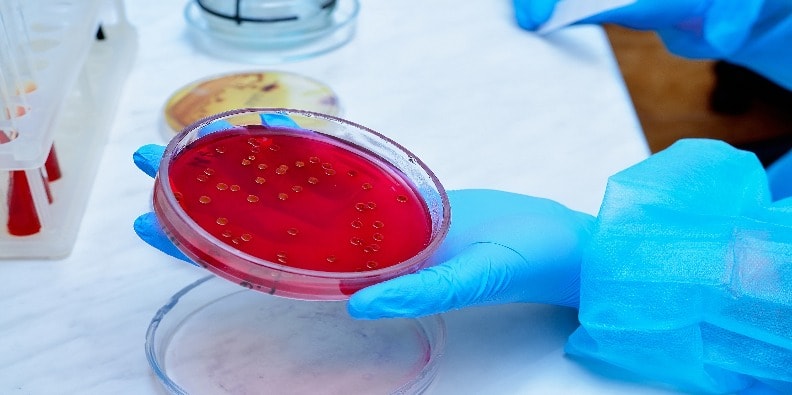Evaluation of Antibacterial

Antibacterial Evaluation of Biocidal Products
Biocidal products are formulations intended to kill or control harmful microorganisms and bacteria are among these microorganisms. Assessing the antibacterial efficacy of biocidal products are tests used to ensure that these products can be used safely and effectively. Antibacterial evaluation is carried out to determine the capacity of the products to kill microorganisms, the continuity of this effect and against which bacteria they are effective.
Evaluation of Antimicrobial Activity and Efficacy in Paints and Varnishes
Antimirobial effects of paints and varnishes used in children's rooms, food preparation areas, laboratories and hospitals are important issues. The presence of microorganisms in the areas we are in is a known fact. Walls, floors, surfaces of different products used can become areas where microorganisms can multiply with the effects of humidity and temperature of the environment.
Bactericidal, fungicidal and yeacidal activities are evaluated in the evaluation of antimicrobial activity in paints and varnishes. Antimicrobial activity is especially important and tested on paints and varnishes used in public, personal and medical areas.
Evaluation of Antimicrobial Activity and Efficacy in Plastics, Metals, Ceramics and Intermediates
Antimicrobial properties have become important in products such as food packaging, garbage bins, spoon holders, cutting boards, etc. produced from plastic, metal and ceramic materials. Antimicrobial properties are more important for products used in food production areas. In areas where there is continuous production and regular cleaning is required, antimicrobial products will be more beneficial in ensuring hygiene.
Staphylococcus aureus (ATCC 6538P) and Escherichia coli (ATCC 8739) bacterial strains are used to evaluate antimicrobial activity in products made of plastic, metal and ceramic materials.
- Microbial Enumeration in Non-sterile Products - Specific Microorganism Enumeration
General microbial load counts and specific microorganism counts are performed on non-sterile products, especially according to the area of use.
Although medical materials are produced under clean room conditions, they have a certain microorganism load. Especially in non-sterile products, the microorganism load is of great importance. The production, storage and transportation conditions of the product are determined by considering the microorganism load.
- Microbiological Examination of Non-sterile Products (Total Applicable Aerobic Count)
Microbial enumeration in non-sterile products is the quantitative counting of mesophilic bacteria and fungi that can grow under aerobic conditions. Microbial counting, especially on pharmaceuticals, is performed to determine whether the product complies with the microbiological requirements specified in the monograph and to determine the quality of the raw material. Testing can be performed using the bulk and spread plate method, membrane filtration method. Microbiological Examination of Non-sterile Products (Test for Specific Microorganisms)
These are the test procedures carried out for the detection of specific (specified) microorganisms that should not be present in non-sterile products. The specific microorganisms required in non-sterile products are as follows.
-
- Microbiological Examination of Non-sterile Products (Test for Specific Microorganisms)
- Staphylococcus aureus (AATC 6538, NCIMB 9518, CIP 4.83, NBRC13276)
- Pseudomonas aeruginosa (AATC 8739, NCIMB 8545, CIP 53.126, MBRC 3972)
- Salmonella enterica ssp. Enterica serotype typhimurium (AATC 14028), Salmonella enterica spp. Enterica serotype abony (NBRC 100797, NCTC 6017, CIP 80.39)
- Clostridium sporogenes (AATC 11437, NBRC 14293, CIP 100651, AATC 19404, NCTC 532, CIP 79.03)
- Evaluation of Antibacterial Activity and Efficacy in Textile Products
Apart from the features expected from textile products such as being non-allergenic, non-carcinogenic, non-toxic, it is also important that they are antibacterial depending on the area of use. While the clothes generally used in hospital environments are expected to be antibacterial, it has become a sought-after feature in products such as daily clothes such as socks, carpets, sofa fabrics, towels, kitchen cloths, athletic clothes, baby items, which we frequently use today, used in home and hotel environments.
Textile products are environments where microorganisms can easily multiply in terms of their structure. Since they provide the appropriate temperature, humidity and nutrients in textile products, microorganisms can multiply and become harmful to the consumer over time. Thanks to its antimicrobial properties, textile products have started to play an important role in reducing or eliminating the damages caused by microorganisms.
In the evaluation of antibacterial activity in textile products, especially; testing procedures are carried out on Staphylococcus aureus and Klebsiella pneumoniae microorganisms.
Antibacteriality in textile products is determined by 2 different methods.
- Dynamic Shaking Method
- Absorption Method
In biocidal products, "Microbial Counting in Non-sterile Products - Specific Microorganism Counting" procedures are carried out.
| Clothes |
Outerwear
Innerwear
Socks
Hat
Gloves
Handkerchief |
| Bedroom Textiles |
Bed
Quilt - Blanket
Sheet
Pillow |
| Home Textiles |
Carpets, Rugs, Mats, Carpet Covers
Curtains
Tablecloths
Cleaning Cloths
Towels |
| Baby Products |
Innerwear
Outerwear
Bedding Products |
| Textiles for Pets |
Pillow
Pad
Absorbent Covers |

